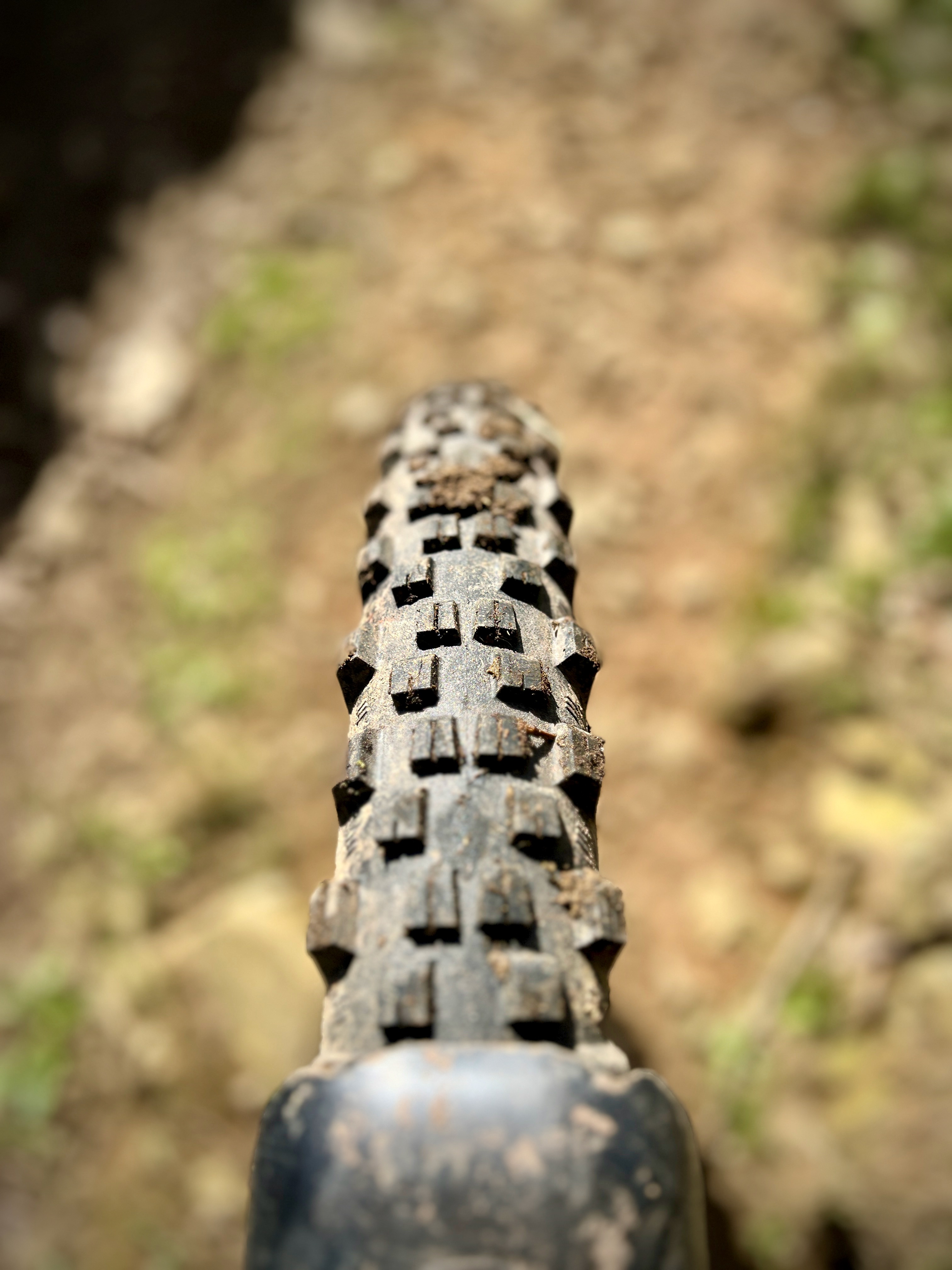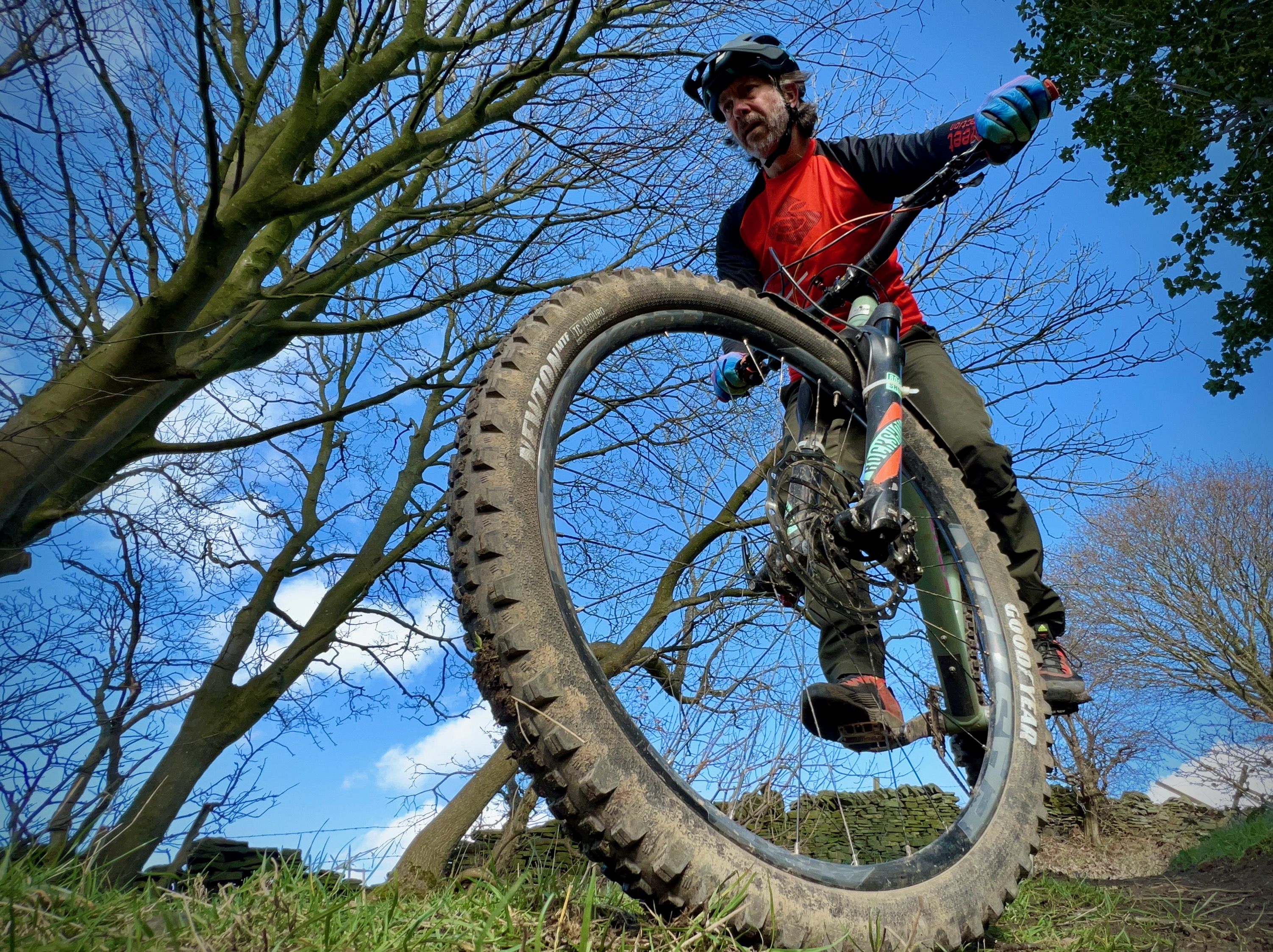The Goodyear Newton tyres are as hefty as they are grippy, and as such they represent a solid choice – perhaps in more ways than one.
- Price: £59.99 (as tested)
- Sizes: MTF – 27.5×2.5, 29×2.5; MTR – 27.5×2.4, 27.5×2.6, 29×2.4
- Compounds: MTF – Trail2, Grip3S; MTR – Trail2, Grip3
- Casings: Trail, Enduro, Downhill
- From: Goodyear
Things I loved
- Excellent grip, cornering and braking in a variety of conditions
- Liked the front profile
- The grip/wear ratio seems excellent
Things I didn’t love
- Fitting them (I’m also fairly nervous about removing them).
- Hefty as all get-out
- Not the most supple
- Wobbly front (undetectable on the trail though)
The Goodyear Tire and Rubber Company was formed in 1898. Initially, as well as bicycle tyres, the company mostly confined itself to the meagre opportunities afforded it by shoeing internal combustion machines of many different types, as well as making airships and blimps and other god’s-law defying mechanisms. However, after abandoning the unutterably colossal potential profits to be made in the bicycle tyre industry in 1975, the company dabbled in the natural gas and crude oil industries before relenting and coming back into the bicycular fold in 2015. Knobbly tyres took a little longer – the first iteration of the Newtons emerged in 2018 as a range of MTB tyres. We tested the Enduro ones, and quite liked them (linky here!).
Nevertheless, all things must change, and Goodyear, in the hope that they could claw some more of that sweet, sweet market share from Maxxis, Schwalbe et al, have totally redesigned their mountain bike offering. Hence, the Newton MTF and MTR combo tested here.

Choose your weapon
The Goodyear Newton MTF and MTR tyres are available in a variety of rubber compounds spread confusingly across the two. You can get both tyres in their ‘Trail 2’ compound – which means 50/60a durometer rubber. And as you move up a price bracket, the MTF also comes in ‘Grip3S’ – 40/42/60a durometers – whereas the MTR gets ‘Grip3’ – 40/50/60a durometers. These (front and rear specific respectively) are supposed to increase traction/handling etc. The compounds have (it says here) been developed in conjunction with Rubber Kinetics – a company which also ensures the soles of your Ride Concepts shoes remain firmly stuck to the pedals.
Each tyre combo is also available in an array of different casings too – trail, enduro and downhill. ‘Trail’ comes in 1x60TPI (threads per inch) with a ‘bead to bead anti cut layer’. Enduro has 2 x 120TPI sidewalls with ‘butyl sidewall support’ and Downhill has a 2x60TPI casing with a particularly chonkin’ butyl sidewall support.
Weight a minute
These ones, though, are the Enduro casings with the Grip3 (Rear) and Grip3S (Front) compounds. One might, perhaps, assume that these are somewhat more svelte than the Downhill bad boys, so it came as something of a shock to plonk them on the scales – the MTF (in its 29×2.5 iteration) weighs in at 1448g, and the slightly more skinny MTR (a scant 29×2.4) is 1272g. I’m not overly concerned by tyre weight, as these things go – but this is some pretty substantial rubber to say the least, and firmly in DH tyre territory.
Fit for purpose
The next surprise was fitting the tyres. I tried to get the MTF onto my trusty Roval carbon rims, but that was a battle I suspected my rim might lose – so eventually I used a different, alloy rimmed wheel. With a fair amount of grunt, two broken tyre levers and a protracted bout of sitting-in-a-corner-weeping, it was on and inflated.
The MTF is pretty substantial-looking, even for a 2.5in tyre, seated on a 30mm rim. It’s noticeably rounded in profile, which should make for smooth progressive cornering, although even after seating my front tyre had a noticeable wobble when spun. A quick assessment suggested that this wasn’t due to any issues with locating the bead on the rim; it seems to be a manufacturing issue. It’s undetectable on the ground, though, so I determined to soldier on rather than insist on a replacement. At least in part, this is because I was nervous about removing it again – I’d only just gotten it onto the rim, and I was still having flashbacks.
The rear tyre was slightly easier to install – at least, using lessons learned from its sibling, I managed to install it onto the rim with only one rather bent tyre lever and a couple of grazed knuckles as casualties. It definitely sports a more square profile than the front tyre, with pronounced side knobs.
Location, location, location
I mainly used the Goodyear Newton rubbers in Calderdale, in both tinder-dry (and then, a bit later, emphatically not tinder dry) conditions, with a few forays down to Bristol to embrace the slither on some off-piste woodland sketch.
Turning the pedals with these new hefty black treads didn’t, thankfully, immediately make me feel as if the wheels were chained to the centre of the earth. They span up relatively easily for their weight, although there’s no denying there was a noticeable rolling resistance on tarmac – knobblies gonna knobble.
Traction, man
Grip-wise, they performed very well. Lots of traction from the back in particular, and they felt predictable and save when cornering. In extremely sketchy, low-speed loose and muddy conditions they equalled my usual Maxxis DHF/DHR combo, or my personal all-round faves, Hans Dampf on the rear and Magic Mary on the front. In the dry they also performed well too; the front was predictable, and it down’t take long for me to begin to trust them when skittering down things I suspect I shouldn’t have been. Braking feel was also good, but to be fair, the faster I rode, the better they felt – the angular momentum generated by their substantial mass helping here I suspect (caveat: I am not a physicist).
A little stiff
Perhaps the main Achilles heel of the Goodyear Newton tyres, in my experience, was lower speeds. I found it hard – perhaps thanks to all that sidewall protection – to get a balance between suppleness and traction at reasonable pressures. At ‘normal’ pressures – around 20 on the front and 22 or so on the rear for me – traction was fine, but the tyres felt a little – stiff. I’d drop the pressure to try to gain a little suppleness, but the front tyre started to wallow. Eventually I found an acceptable compromise for my riding style and the local conditions, but it took a good deal of experimenting to get there.
Overall
In brief then, the Goodyear Newton tyres are as hefty as they are grippy, and as such they represent a solid choice – perhaps in more ways than one.
More Reviews
Top Rated
Signing up to our email newsletter is a great way to support us. The more people who sign up the more sponsors become interested in us.











